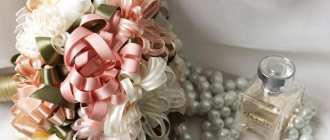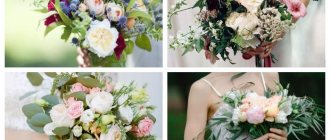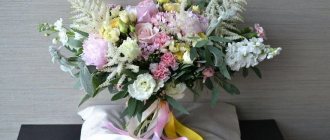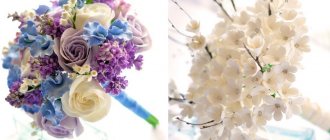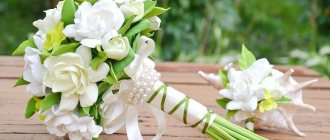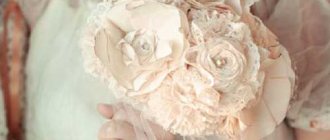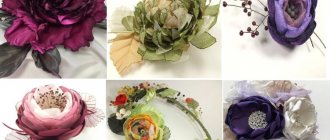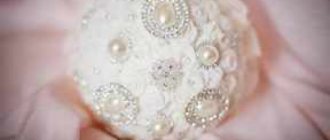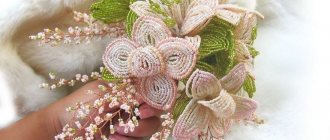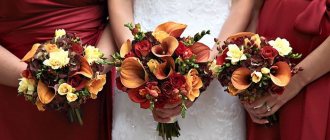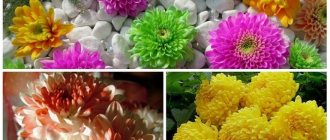To create a beautiful bouquet, you don’t have to contact a florist. Moreover, it is not necessary to make it from flowers. You can make a bouquet yourself from fruits, toys, and sweets. And in general from everything that comes to mind.
In this article we will tell you:
- What you need when making a bouquet
- What types of bouquets are there?
- How to make a bouquet of living and non-living flowers How to make a spiral bouquet of flowers
- How to make a round bouquet of flowers
- How to make a parallel bouquet of flowers
- How to make a bouquet of fruits and sweets
Materials and tools
To create floral arrangements, you need to prepare the following materials.
- Floral sponge. It serves as the basis for compositions. It is placed at the bottom of any container - a basket, a hat box, a vase, to fix flowers and other elements. Flowers stuck into it stay fresh longer and can be watered.
- Thin flexible wire. It will be useful not only for strengthening the composition, but also for the manufacture of its individual elements.
- Floral tape is necessary for covering cuts on the stem, wire, packaging and decoration. Its properties are reminiscent of elegant electrical tape made from synthetic non-woven material. It is easily stretched, follows the shape of the element, is tightly and securely fixed thanks to the adhesive layer, and prolongs the life of the cut plant.
- Vases, bouquet holders, satin ribbons of different colors, beautiful wrapping paper, baskets, hat boxes, plugs and other accessories for decoration. We’ll give you a little advice right away: follow fashion trends in floristry. On social networks, subscribe to famous florists or professional communities to keep abreast of all the new products.
- Transparent cellophane film can be used as technical wrapping, for example for transportation or protection against damage.
As for tools, first of all you will need:
- pruner,
- scissors,
- floral knife.
It is advisable to have these tools in pairs: one for household purposes (cutting ribbons, paper, etc.), the other strictly for cutting and processing flowers. Keep your tools sharp at all times. Dull blades damage plants and this negatively affects the overall quality of the arrangement.
- Hot glue gun (the simplest model with a power of 100 to 150 W is enough). It is needed to connect elements.
- Stapler - for the same purpose.
- Wire cutters, thin-nose pliers and pliers for working with wire.
- The color wheel is a very convenient cheat sheet, thanks to which you can accurately choose colors for bouquets and other compositions. For beginners, this is a must-have tool.
Floristry tools must be of good quality so that they are convenient and easy to work with. Cheap models tend to break down very quickly.
What is floristry? Where do you study to become a florist? Is it possible to learn how to make bouquets yourself?
Floristry refers to the skills of making bouquets and compositions from various plant materials : flowers, leaves, stems, cones, individual branches and parts of plants. Recently, the tendency to collect bouquets not only from plant components has been gaining popularity: food, dried fruits, toys, decorative items and clothing, and cosmetics are used.
The skills of working as a florist can be learned through courses, which in the modern world are massively conducted online and offline. If you have the makings and a creative streak, the process will go faster, and your own ideas will be added to the basic knowledge.
If you don’t have such skills, but have a strong desire to learn, you can do this by applying additional diligence. Students who have completed training in landscape design often become florists. These are, of course, different professions, but in principle they can complement each other.
Courses are a more targeted type of floristry training , especially since now you can study in any field, regardless of whether you have skills or not.
There are courses for beginners, where they teach the basics, and there are courses for experienced florists, which improve both the level of skill in general and teach different areas: wedding, family, temple, business floristry.
You can find free training lessons on the Internet, study them and try yourself in this matter. Once you get a job in a flower shop, you can learn how to make bouquets and compositions. But what is the skill level of the teacher and what he can give you is a big question.
The most effective (albeit expensive) way to become a florist is to buy individual, full-time training from a real professional in floristry. Knowledge will be given by an experienced florist, and bouquets and arrangements will be assembled under his guidance. And after graduation, most likely, you can turn to him for advice.
Self-training using video lessons also takes place in the practice of many florists, however, this method is better suited for those who already have some practical and theoretical basis.
Principles of composing floral compositions
Floristry, like any other art, has its own rules and principles that must be strictly followed in order to create a beautiful composition that pleases the eye. Even very experienced florists don’t make bouquets at random.
Ideally, a floral arrangement should meet the following requirements:
- harmony, that is, all elements form a single whole;
- the design matches the chosen style;
- variety of textures and structures of plants;
- a well-chosen color scheme, this is where the color wheel will help you;
- dynamism, the presence of one or more focal points;
- compliance with the golden ratio rule;
- balance of all parts of the composition.
Let's look at each quality in more detail so that you can freely navigate the theory of floristry.
Where can I take courses in floristry and design, cost in Moscow, St. Petersburg
Mastering this craft is a completely feasible task. You can undergo training using the traditional method by attending classes in specialized centers. The masters there teach both the terms used in floristry and the basics and various techniques for performing compositions.
The cost of such courses in Moscow and St. Petersburg varies from 30,000 to 50,000 rubles. The average training period is 10 days.
You can learn the basics of floristry online. Masters conduct courses for beginners remotely, for example via Skype, explaining step by step and showing all the nuances of the work, as well as answering students’ questions in real time.
The cost of online courses varies from 5,000 to 10,000 rubles. It should also be noted that there is the possibility of free training in this craft using freely available videos, text articles and books.
Article design: Natalie Podolskaya
Floristry styles
- The vegetative style suggests that the composition should be as close as possible to the natural image. This style is characterized by a muted color palette; twigs, berries, moss and other natural materials are often used in the design. It is important to ensure that the plants belong to the same season. This is a very difficult style for beginners.
- Decorative style. Any combination of plants is allowed here, the main thing is that they look organic and none of them lose their flavor. In decorative compositions, you can safely use the most unusual finishing materials; the more textured they are, the better. Often used for room decoration and composition using a floral sponge.
- Linear style. The composition is built according to the principle: clear lines, minimum materials, maximum naturalness. Most often, such compositions use plants with curved or long stems, and the elements are arranged asymmetrically.
- Massive style. The composition has a clear form. All elements are tightly connected to each other or to the frame. There are no strictly defined focal points; the colors, size of the buds and lines smoothly transition into each other.
The decorative style is used mainly for making bouquets. The rest are most often found in interior design.
Dynamics and focal points
If you arrange the elements correctly, the composition will turn out dynamic. Looking at it, a person will move his gaze from one plant to another, and this will not only bring aesthetic pleasure, but will also relax and relieve stress.
The focal point is the most important element that attracts attention in the first place; the entire composition is built from it. Multiple focal points are allowed. This could be a large flower, unusually shaped leaves, varying degrees of bud opening, or different flower positions in height.
Symbolism of flower arrangements
Not only does each plant individually mean certain feelings, but also the combination of several species with each other. For example, a single scarlet rose expresses passion, but next to white and pink buds, it can be interpreted as suggesting a serious relationship based on love and trust. It is interesting that it is generally not recommended for established, fairly old people to give the “queen of gardens”, either in a single copy or in mono-bouquets. This is considered overly playful.
Only in early youth is it appropriate to give spring lilac compositions. Her lush brushes indicate the birth of first love. More mature and less ephemeral feelings are expressed with a bouquet of tulips, irises and chrysanthemums.
The combination of lilies and eustoma can be perceived as a hidden compliment to girlish beauty. Camellias, peony roses or gardenias also speak of the admirer's admiration. But if the bouquet arrangement consists mainly of exotic flowers, then the girl to whom it is addressed is considered unusual and stands out from the crowd.
You should be careful when giving daffodils, yellow carnations, and petunia to your loved ones and loved ones - these plants symbolize negative feelings.
How to combine textures in a composition?
Each flower has its own surface of leaves and petals. This is called plant texture. It is very important to take this into account when composing a bouquet. Facts are divided into several groups.
- With a metallic sheen. This includes plants with shiny smooth leaves and inflorescences, for example, anthurium, begonia, as well as with matte foliage, for example, sedum.
- The glass texture is formed by smooth, translucent petals and leaves, such as those of bells and irises.
- The porcelain texture is obtained from the dense surface of the flowers, shiny-smooth or, conversely, slightly rough and matte. These are, first of all, orchids and hyacinths.
- Velvety texture - the petals feel like velvet or soft suede to the touch. This group includes violet, Saintpaulia, and some varieties of roses.
- The brocade texture also implies a soft surface, only more silky, with rich shades. These are marigolds, primrose, gaillardia.
- The silky texture is elegant large petals, smooth and tender, reminiscent of natural silk. The most striking representatives are poppies and anemones.
- The wool texture is characterized by flowers that are similar in appearance and softness to alpaca wool or cashmere. These include astilbe, ageratum, cotton grass, and some flowering herbs.
- Flowers with a somewhat rough rustic texture: helianthus, rudbeckia and others, make bouquets in a rustic style - cute and unpretentious.
When composing a composition, it is customary to combine flowers either as close in texture as possible, or strictly opposite. For example, shiny flowers look great against the background of matte velvety leaves.
How to wrap one rose
A single flower - such a laconic gift - can become a declaration of love, an apology, or just a present to lift your spirits. A single rose is a great gift for a lover of minimalism. It is often easier to figure out how to pack an elegant bouquet of three or five flowers than a single rose. For the flower, you should choose film or craft paper. The packaging should not be made lush. Be sure to add decorations to the stem in the form of a ribbon, a colored “cup” made of film or foil. The rose also looks great under the cover of a vacuum flask.
Golden ratio rule
The golden ratio is the basis that every florist must know and strictly observe. It means that the harmony of the composition is achieved by observing certain proportions when assembling it. Thanks to this, the composition looks like a single whole.
In floristry, ratios of 2:3 and 3:5:8 are used. Let's take a closer look at how they are used in practice.
- Height proportion. If you are making a composition in a vase, then you need to take its height into account. It is better to use a ratio of 2:3. The height of the large vessel will be 3 parts, and the flowers, respectively, two parts. It can also be the other way around: the flowers make up 3 parts, and the vase – two. In a bouquet, proportions are calculated starting from the middle of the bunch. The optimal ratio is 3:5. Three parts - bottom, five parts - top.
- The length proportion is calculated depending on the base or diameter of the vessel according to the same principles.
- The proportion of height and length is calculated for horizontal compositions, taking into account the height of the vessel. Here you should adhere to the ratio of 3:5:8.
- For asymmetric compositions, calculate the proportion of the mass of the material. The main mass of colors is 8 parts, the distant one is 5 parts, the near one is 3 parts.
It is useful for novice florists to copy compositions compiled by experienced florists and carefully monitor compliance with the ratios. So, a professional sense of proportionality will come naturally
Symmetry or asymmetry?
Mentally draw the geometric axis exactly in the middle of the composition. If the material is at an equal distance from it, then this indicates symmetry. If all the parts look different, then this is asymmetry.
With symmetry, the main elements are placed in the center of the composition. The remaining elements are less significant; they complement the main ones, emphasizing their color and shape. Symmetrical compositions are usually used on special occasions, as well as when decorating official events and office spaces.
With asymmetry, the main elements are not placed strictly along the axis, but in deviation from it, but it is important to maintain the 3:5:8 ratio, which we wrote about above.
- The main part is usually placed on the left side of the axis, and the remaining elements on the right. The smaller they are, the further away they should be.
- Light flowers enhance asymmetry, dark ones smooth out.
- As a result, the plants look natural, as if we found them in nature.
Asymmetrical compositions are usually used to decorate festive events and spaces intended for relaxation and leisure.
What else is important to know?
Firstly, it would be a good idea to study the language of flowers. Even though this tradition is a little outdated, many people find it very beautiful and romantic. Special reference books will help you learn basic “phrases” and “words”.
Secondly, be sure to take into account the reason for which you are making the bouquet. Some flowers traditionally accompany funerals, others - weddings, dates, birthdays, and others - are appropriate only in business compositions. The palettes and design are completely different in all cases.
Thirdly, many plants are sworn enemies, and some, on the contrary, are friends with each other and even heal each other. Be sure to check the color combinations in the gardener's reference book.
As you can see, putting together a bouquet of living plants is painstaking work that requires the florist to be thoughtful and knowledgeable about the basic geometry and biological characteristics of each flower.
What types of bouquets are there?
Not a single holiday would be complete without a gifted bouquet. They are received on September 1, on birthdays, weddings and other celebrations. A bouquet of traditional flowers does not arouse the same interest, unlike one made from toys or banknotes. Their original appearance can surprise people around them.
All flower bouquets can be classified according to the following forms:
- spiral;
- round;
- parallel.
The name of the form of the composition will come from how the flowers were stacked together.
Floristic techniques
Let's look at a few basic techniques for creating a beautiful, harmonious floral composition.
- A boutonniere is a traditional mini composition that complements a man’s suit at a wedding, anniversary, prom and other celebration. It can also be attached to a women's bracelet. One large flower is placed in the center of the composition, green branches and other decorative elements are placed on the sides. On one side, the boutonniere must be flat so that it can be easily secured. Details on how to make a boutonniere are shown here
- The parallel technique is usually used to create tabletop arrangements and vertical bouquets, which are usually given to men. Flowers with large buds are suitable for a bouquet. The essence of the technique: the plants are laid in a ladder, so that the heads of one row are located lower than the previous one. The stems are secured to each other with tape. If you want to create a tabletop composition, you will need a floral sponge and flowers with stems of different heights. It is composed in the same way as a bouquet: one row is lower than the other. How to correctly assemble a bouquet using the parallel technique is shown here
- The spiral technique is used to create most bouquets. To do this, you need to take flowers with even, dense, long stems. The essence of the technique is that when assembling, one flower is placed at a slight angle in relation to the previous one. If you assemble a round spiral bouquet correctly, it will stand on the table without a stand. You can see how to do everything right here
- The asymmetrical technique is very complex; it requires imagination and knowledge of the laws of floristry to create a truly beautiful elegant composition. The bouquet uses flowers, twigs of different shapes and heights. It is desirable that only one element stands out, and the entire composition will be built around it. See more about this here
How to compose a composition, watch in this video
You can even make a bouquet from one flower, the main thing is to decorate it beautifully and unusually, following the rules of floristry, as shown in this video
Tips for making a bouquet
When starting work, you should adhere to certain rules. The style of the bouquet should correspond to the event, age and gender of the person for whom it is intended.
The composition should look natural. To learn how to make a bouquet with your own hands, use step-by-step instructions.
Each flower in the composition should be visible at first glance. The structure being created can include plants of different types, of the same color, but in different shades.
White color goes well with other tones. Pay attention to the stability and size of the composition.
What is important to know about bouquets of artificial flowers?
The main advantage of artificial flowers over real ones is that they are durable and can be placed in places where real plants cannot survive. If you decide to create a composition of artificial flowers, choose high-quality products. They are very beautiful and look natural, and also last longer with their rich color and ideal shape.
Bouquets of artificial flowers are assembled according to the same principles as those made of real flowers. But here it is important to consider the placement of the composition. We'll give you some interesting ideas.
- For spacious rooms, such as a living room, bouquets of roses, peonies, and lilies are ideal. Here you can also use floor vases with tall flowers.
- Place a small bouquet of bright multi-colored flowers on the jardiniere in the hallway - chrysanthemums, asters, gerberas, tulips.
- Delicate compositions of small roses, violets, and peonies will look beautiful on a dressing table or bedside table in the bedroom.
- Artificial flowers in pots will be an excellent decoration for the walls in the bathroom. They can also be placed in the office.
- Small pots of flowers and herbs look amazingly beautiful on kitchen shelves and add coziness to the room.
Also, with artificial plants you can create interesting wall panels, collages and other compositions that will become the main decoration of the interior.
Flower care
Real and artificial flowers require certain care. Floral arrangements also use dried plants and require different care than live and artificial flowers.
Caring for fresh flowers
Since plants inevitably begin to decompose in water through the process of rotting, which ultimately leads to the proliferation of bacteria, the water in which the flowers are placed must be as clean as possible. This approach will slow down the wilting process and the flowers will last longer.
We must not forget that substances contained in tap water can also negatively affect the life of a flower, so it is better to use water from a filter. The use of sprayers to cool and moisten flowers is not prohibited.
Rules for caring for fresh flowers:
- It is necessary to remove all shoots and leaves located on the stem, which will be immersed in water. After this, the stems should be washed.
- The stem should be cut at an angle and pour as much water into the vase as possible, then the flowers will last longer. The optimal water temperature in this case is 7°C.
- It is highly not recommended to place a vase of flowers next to heating appliances, this will shorten their life. Flowers will last longer in a well-ventilated room with dim lighting, away from direct sunlight.
Caring for dried flowers
On average, dried flowers and plants can be stored for up to a year without harming their subsequent use in floral arrangements.
Bunches of dried flowers are stored in a suspended state
There are rules that allow you to extend this period:
- Dried flowers can be treated with a special fixative for floral arrangements.
- Dried material should be kept away from light, especially direct exposure to the sun.
- To blow off dust from compositions made of dry material, you can use a hairdryer, but only at low power, otherwise there is a risk of ruining the composition.
- Rooms with high humidity should be avoided.
- The best option for storing dried plants is to create bunches and then hang them on hooks.
- Dried flower heads can be stored in a cardboard box, after pouring a small amount of silica gel onto the bottom and covering the top with wrapping paper.
Caring for artificial flowers
Artificial flowers require less care to remain in good condition.
The leaves of artificial flowers can be gently wiped with a soft cloth.
Here are the rules that will help avoid damage to such material:
- To remove dust, you can use a hair dryer at low power and a soft cloth;
- Direct exposure of the material to sunlight should be avoided;
- Artificial flowers should be stored in a cardboard box, packed in a vertical position to avoid dents and deformations.
How to make a bouquet of sweets?
Knowledge of floristry will come in handy if you want to congratulate a loved one in an original way with a sweet gift. For this you will need:
- candies;
- corrugated paper: green for sepals, yellow (or any other color) for petals;
- tape with a green adhesive layer;
- scotch;
- long wooden skewers;
- wrapping;
- small scissors;
- floral sprigs and ribbon for decoration.
Execution order:
- According to the number of candies, cut out blank strips from paper: wide ones for the petals, narrow ones for the sepals. They should be such a length that they can be loosely wrapped around the candy and secured.
- Fold the strip like an accordion, cut out the contours of a petal or sepal with scissors. Repeat the same with the remaining strips.
- Wrap the candy in petals and secure with a piece of tape.
- Wrap the candy in a sepal and secure with a piece of tape.
- Repeat steps 3 and 4 until you run out of candy.
- Attach the resulting buds to wooden skewers with tape, wrap the stem a few centimeters down.
- Collect a bouquet, fasten the stems together with tape or tape. If you wish, you can supplement it with floral branches.
- Wrap in beautiful wrapping paper and tie with matching ribbon.
Done!
Master class: making a flower arrangement in a box
You will need:
- roses with large buds;
- succulents - aeonium, stone rose, pachyphytum, preferably the same size;
- beautiful decorative box and drawer;
- film;
- floral sponge;
- floral knife;
- stapler;
- ribbon for decoration.
Procedure:
- Cut the sponge to the size of the box or drawer.
- Place the film down and secure the edges along the walls with a stapler.
- Place a floral sponge on the film.
- Trim roses so that they are slightly taller than succulents.
- Fill the sponge with plants as follows: a row of succulents, a row of roses, in any direction.
- Try not to let the sponge show between the flowers. You can fill the gaps with any decor, for example, straws made of paper or other material.
- Wrap the box with ribbon and tie it in a pretty bow.
- Wrap in beautiful wrapping paper and tie with matching ribbon.
Select the palette according to the color wheel. Draw a diagram of the arrangement of flowers in advance so as not to accidentally damage the plants when laying them out.
That's all!
Useful tips for beginners
- Before making a bouquet or composition, soak the flowers with water for several hours. You can add Crisal powder to the water. This will help the flowers stay fresh longer.
- Remove all leaves and shoots that will be under water or inside the package.
- Cut the stem at an angle and only in water, using pruning shears or a florist knife.
- For women, it is customary to make round bouquets, and for men, tall, elongated bouquets.
- The optimal number of flowers in a bouquet is no more than three types.
- Use flowers with half-closed and newly opened buds; such a bouquet will last longer.
- Lighter flowers of calm shades should be located along the edges, and darker and brighter ones should be placed closer to the middle.
- You cannot combine exotic and wildflowers in one composition. It's vulgar.
You will find some more useful tips in this video
Fashion trends in floristry
Fashion, as a socially established characteristic of good taste, changes every year. This trend affects not only design decisions in the manufacture of clothing or the creation of new types of perfume.
Professional florists also annually create new styles from fresh flowers when arranging beautiful bouquets, presenting photos of their work at various exhibitions and catalogs.
In the package
Following global fashion trends, florists are increasingly offering customers arranging flowers in creative packages.
This original packaging with stylish handles has displaced outdated film from the market and is offered in the following options:
- Craft bags made of stylish and pleasant to the touch paper, resistant to moisture.
- Cardboard packaging, which is assembled by hand from a pre-prepared sheet at the factory. It is produced in the form of a polygon or round shape, with a bottom or a slot for flower stems. The handles on such a bag are usually made of fabric ribbons or in the form of ropes, which resembles a standard gift bag.
Considering that the whole world is fighting against environmental pollution, design solutions for packaging in the form of bags using plastic are gradually becoming a thing of the past, giving way only to easily recyclable materials.
In envelopes
One of the fashionable trends in floristry of late is the packaging of small packages in boxes stylized as voluminous or flat envelopes.
Beautiful bouquets of fresh flowers can be arranged in boxes stylized as envelopes
Each bouquet decorator has a wide range of products at his disposal:
- Craft, cardboard and moisture-repellent paper.
- Plain, using bright or delicate shades.
- With thematic designs, which allows the customer to accurately select the packaging for the occasion of the celebration.
- With edging made of foil tapes or fabric braid.
- With a velvet surface, pleasant to the touch.
- With various interior finishing options.
- With congratulatory inscriptions, including personal ones, made to order.
The size of the envelope is selected depending on the number of flowers in the bouquet and the presence of decorative elements. Such packaging can be stored with the bouquet for a long time, because florists provide special wet capsules to maintain the vital activity of flowers.
Gift wrapped
Beautiful bouquets of fresh flowers, photos of which are presented later in the article, are often presented in gift wrapping.
In each fresh flower salon, the customer can ask the master for the following types of design:
- Matting - the material was very popular 20 years ago, when flowers were sold at every metro station in the capital. Today, this wrap, along with colored textured mesh, is still used, although the design style has changed somewhat. In the windows of fashionable flower shops you can find wicker, paper and plastic nets with large constant or non-uniform cells of various colors.
- The style icon of recent years in the flower industry has become craft paper, widely used due to its impeccable appearance, variety of shades and environmental friendliness. A bouquet decorated in such packaging has a decent appearance, but the paper does not tolerate contact with water.
- Another type of paper packaging is crepe, which differs from craft in that it holds its shape due to the rigidity of the material, and even the longest flowers will look perfect in such a wrapper.
- Some craftsmen who want to give the bouquet a voluminous appearance, before using the packaging, fix the flower stems on a special plastic or cardboard frame. After registration, this element is securely hidden under a decorative shell and the illusion of a lush bouquet is created.
- The last fashionable material in the ranking is felt, which is rarely used by florists. But with a high level of skill, you can create a beautiful bouquet of fresh flowers that will not be afraid of water or stain your hands due to weak pigment.
- Another trend is hat boxes for flowers, which can be of any shape, size and color. The products are made of thick cardboard, and the flowers inside are set in a soft, damp sponge, which preserves their original appearance for a long time.
- Next season, florists will begin to offer exquisite bouquets in metal buckets or boxes. This trend has long been developing throughout Europe, and gradually reached Russia.
All of the listed types of packaging can be found both in the windows of florist salons, and can be ordered by looking at photos in catalogs on thematic portals.
A separate item worth highlighting is the wedding packaging for the bride’s bouquet. Since the beginning of 2000, this element has been installed in a moist floristic flask, called a “microphone,” which allowed the flowers not to wither throughout the day.
Today, this design method is gradually becoming a thing of the past, and brides willingly order bouquets for wedding photo shoots, decorated with long lush ribbons.
